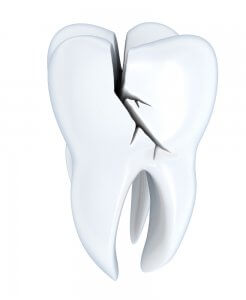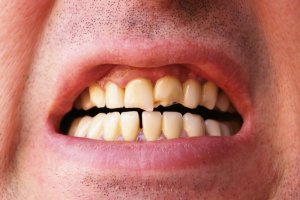There are many reasons why you may have a broken, cracked or chipped tooth. Whether or not you’re experiencing pain, the good news is that tooth damage can often be repaired.
In this article you can read about the difference between chipped, cracked (fractured) and broken teeth. We also explain the treatment options for these problems, including chipped tooth repair. What should you do about a cracked front tooth? And is it possible to fix a broken tooth?
Keep reading to find out all the options for improving the function and aesthetics of your smile after damage to one or more of your teeth.
In This Article
Different types of tooth damage

Did you know that your tooth enamel is the strongest tissue in your body – even tougher than your bones? Still, a number of things can cause broken, chipped and cracked teeth, including:
- Chewing something hard like ice, nuts or boiled sweets
- Biting down on something hard unexpectedly, such as an olive stone
- Using teeth for things you shouldn’t (e.g. opening a bottle or cutting thread)
- Receiving a blow to the face or mouth
- Falls and other accidents
- Underlying decay which weakens teeth
- Erosion of enamel from acidic foods and drinks
- Old fillings which have fallen out or no longer support the remaining tooth
Where the tooth enamel is already weakened or the tooth has decay beneath the surface, it will be more susceptible to damage from other sources.
The treatment options for your tooth injury will depend on how serious it is. A tooth with a small chip is straightforward to treat, usually either by polishing or filling it with composite material. However, a seriously broken or fractured tooth may have to be extracted.
Whatever type of tooth damage you have, it’s important to see your dentist as soon as possible, even if you have no pain. This is because without the proper treatment the tooth may sustain further damage.
Chipped teeth
Chips are relatively common. They can range from a small chip in the tooth enamel to a more noticeable part of the tooth missing. When just the enamel is chipped, there shouldn’t be any pain. If the chip has exposed the nerve inside the tooth, however, it is likely to cause painful toothache.

There are four main reasons for fixing a tooth that is chipped:
- It’s causing you pain
- It has left a sharp surface which may cut the soft tissue in your mouth
- The softer layer of dentin inside your tooth is exposed and at risk of decay
- You don’t like the way it looks
What to do with a chipped tooth
If a piece of your tooth has chipped off and you still have the fragment, store it in milk and visit a dentist as soon as you can. They may be able to attach the fragment back in place with a dental adhesive.
Don’t worry if you can’t find the fragment, as there are other ways to fix a chipped tooth.
Determining whether a chipped or cracked tooth is an emergency depends on if the fracture is very painful or if it has left sharp fragments that result in oral trauma. If the tooth is chipped but isn’t painful, you can wait to see your dentist. If the injury can wait until your dentist can see you in the next couple of days, it typically isn’t defined as a “dental emergency”.
In the interim, treat your chipped tooth by cleaning your mouth by rinsing with warm water. If swelling or pain occurs, a cold compress can be applied to the outside of your face over the affected area. Talk to your dentist before taking a painkiller or using numbing gel because it can damage your gums.
Dr. Shane S. Porter, Premier Dentistry of Eagle
Chipped tooth repair
In the case of very small chips, treatment might not be clinically necessary. If there is a sharp surface on the remaining tooth, your dentist will probably polish the tooth to smooth it out and prevent cuts inside your mouth.
For larger chips, they may build the tooth back to its original shape with a kind of filling – a process known as dental bonding. This can be done using a tooth-coloured composite material or silver amalgam.
Provided there is no decay in the tooth that needs to be removed, bonding doesn’t require an anaesthetic. The dentist roughens the surface of the tooth using a gel then adds adhesive. After that, they apply the bonding material and mould it to the desired shape. It’s then hardened using UV light.
This fascinating video shows that dental bonding is just as much an art form as it is a medical procedure:
If you have a chipped front tooth you may want to have it repaired simply for aesthetic reasons. Where the chip is too large for bonding, you will have the option of a veneer or crown.
A chipped molar (back tooth) may be easy to forget about if there is no pain. However, you should still get it checked out to see how much of the inner tooth is exposed. Dentin decays more easily than enamel, and if it becomes infected you might need more complicated treatment later on.
Can you repair a chipped tooth at home?
If you’re unable to get to a dentist for some reason, it is possible to do your own temporary chipped tooth repair at home. You can buy a tooth repair kit to fill in the part that has chipped off. This can be a good solution if the remaining tooth has a sharp edge or an exposed nerve that’s causing you pain. However, it’s not a substitute for visiting the dentist for a more permanent fix.
Cracked teeth

There are different degrees to which teeth may be cracked or fractured:
- Craze lines: These minor cracks only affect the outer enamel and shouldn’t cause any pain. Your dentist may polish the surface to smooth out any rough areas, but there is usually no other treatment needed.
- Cracked tooth: The crack gradually spreads from the chewing surface of the tooth towards the root (pictured).
- Split tooth: When a tooth has cracked in half vertically it is usually very painful. A cracked molar with more than one root may be partly salvageable.
- Vertical root fracture: These cracks begin in the root and spread to the outer surface of the tooth. They often cause painful inflammation and infection around the tooth.
Cracked tooth repair
If a crack is spotted early enough, it’s often possible to save the tooth. Although the crack can be filled, it can easily spread further if the tooth is not strengthened with a crown or cap.
If the pulp of the tooth has been damaged from the fracture, you may need root canal treatment before the crack is filled. This involves removing the tooth root and replacing it with a root filling.
Left untreated, a crack will develop into a split tooth. At least one part of the tooth will have to be removed. If one healthy root remains, it may be possible to perform root canal treatment and apply a dental crown to the remaining root. Otherwise, the whole tooth will be removed.
Extraction is usually the only way to deal with a vertical root fracture.
Broken teeth

When a large part of a tooth breaks off it is often very painful, as the break can expose the nerves in the dental pulp. You might see that the inside of your tooth is bleeding.
If you have a broken tooth with no pain, that doesn’t mean there is no problem. It’s possible that the tooth is already so badly decayed that the nerves have been destroyed. If left untreated, the infection can spread through the tooth root and cause an abscess.
Decay-induced breaks often happen to wisdom teeth and back teeth, which are harder to clean. If you have a broken wisdom tooth or rear molar, your dentist will assess the damage and recommend a treatment – whether that be restorative work or extraction.
What to do if your tooth breaks
As with a tooth that has chipped, you should keep the broken fragment in milk if possible. Your dentist may be able to fix it back in place, although if there is underlying decay you’ll need other treatment.
Avoid eating if possible, or stick to soft foods and don’t bite down using the broken tooth. If you’re worried about a sharp edge cutting your tongue or mouth, cover it with dental wax or sugar-free chewing gum until you can see a dentist.
Broken tooth repair and treatment
Broken front teeth are often repaired by dental composite bonding (described above) or dental veneers. These thin coverings are applied to the front of the tooth to restore its cosmetic appearance. Where damage is extensive, a crown may be more suitable.
Your back teeth may suffer from a broken cusp, where part of the chewing surface breaks off. In this case, there probably won’t be much tooth pain because the pulp is still well protected. Your dentist may be able to fill the broken area, or you might need an inlay or onlay.
These restorations are a kind of mid-way point between fillings and crowns. They only cover part of the tooth surface, like a filling, but they are manufactured in a lab to be an exact fit for your tooth, like a crown.
Crowns are often needed to fix badly broken back teeth because the original tooth structure isn’t strong enough to take biting pressure any more.
Where there is extensive damage – particularly from decay – and the tooth can’t be saved, extraction is the only option. Broken tooth extraction can be more complicated than the standard tooth extraction procedure. This is because the tooth can crumble or break further while the dentist is trying to remove it.
Getting dental treatment
If your tooth has broken or cracked and is causing you severe pain, you should make an emergency dental appointment. You can read more about what counts as a dental emergency here. In the meantime, take an over-the-counter painkiller such as paracetamol to keep the pain at bay or try one of these home remedies for toothache.
If you have a chipped, cracked or broken tooth with no pain, you should still arrange to see a dentist about it soon. You may need some treatment to protect your tooth from infection or to strengthen it against further damage.
Sharp edges can be covered with sugar-free chewing gum or dental wax to prevent injury to the inside of the mouth. You should only eat soft foods and avoid using the damaged tooth until you have visited a dentist.
The cost of tooth repairs in the UK
Any clinically necessary repairs to the tooth should be covered by the NHS, provided you are eligible for NHS treatment. The cost will depend on the type of treatment you need. In the table below you can see the NHS dental charges for some of the most common treatments required to repair tooth damage:
Treatment | NHS Band | Charge |
Emergency out-of-hours visit | 1 | £23.80 |
Initial examination and advice | 1 | £23.80 |
X-rays | 1 | £23.80 |
Scale & polish | 1 | £23.80 |
Fillings | 2 | £65.20 |
Root canal treatment | 2 | £65.20 |
Extraction | 2 | £65.20 |
Inlays & onlays | 3 | £282.80 |
Veneers (rare) | 3 | £282.80 |
Crowns | 3 | £282.80 |
If you need more than one of these treatments as part of a single treatment course, you’ll just pay the highest applicable charge.
Your dentist will discuss your requirements and treatment options at your consultation. You may choose to have private treatment for certain repairs, for example if you would prefer a tooth-coloured or gold filling to a silver metal one.
Note that veneers are only offered on the NHS when they are the only possible treatment; not as a more aesthetically pleasing alternative to bonding. If you choose to have veneers for cosmetic reasons, you’ll have to pay for private treatment.
Avoiding teeth injuries

If you or your child play a contact sport like hockey or rugby, it’s best to wear a mouthguard. ‘Boil and bite’ style mouthguards are available in pharmacies and sports shops but provide limited protection.
A custom fitted mouthguard from your dentist will provide better fit and protection. However, these come at a higher cost and will have to be replaced regularly for growing children. You can read more about choosing a mouthguard on Dental Trauma UK’s website.
Although you can’t prevent accidents from happening, you can look after your teeth to help keep the enamel strong. Ways to maintain healthy teeth include:
- Follow a good daily dental hygiene routine
- Don’t rinse with water after you brush (as this washes away fluoride which strengthens tooth enamel)
- Limit sugary snacks between meals – raw vegetables or unsalted nuts are good snacks to keep teeth clean
- Drink fizzy drinks through a straw to keep the sugar and acid off your teeth (or don’t drink them at all)
- Chew sugar-free gum after eating and drinking to neutralise the damaging acid in your mouth
These steps might mean the difference between a small chip and a large break if you do damage your teeth.
Replacing a damaged tooth
If you have to have a tooth removed because of damage, don’t despair. There are several ways to replace broken and damaged teeth.
Dentures (also known as false teeth) are the most affordable type of artificial teeth. They are attached to an acrylic plate which slots into place around your other teeth. These removable teeth are usually available on the NHS for the band 3 treatment charge.
A dental bridge is a more permanent way to fill a gap between two healthy teeth. The artificial tooth is fixed to the two neighbouring teeth using caps. You may be able to get a dental bridge on the NHS, and they typically last for five to ten years.
Finally, you may consider getting teeth implants. These are inserted into your jawbone, making them a strong and lasting way to replace your natural teeth. They are, however, the most expensive option since they’re not available on the NHS.
If you want to get implants to replace damaged teeth, you can save a lot of money by getting dental implants abroad. Clinics in Hungary and Poland, for instance, offer implants for 60-70% less than you’d pay in the UK.
Conclusion
If your tooth gets chipped, broken or cracked, the good news is that there are plenty of ways to save the tooth and restore its function and appearance. Tooth repair procedures include fillings, bonding and crowns.
If you’re in any pain or there is a risk of a sharp edge cutting your mouth, get to a dentist as soon as you can. Even if you’re not experiencing pain, visit a dentist soon to assess any underlying problems and avoid further damage to the tooth.
Remember that getting regular dental checkups is really the best way to identify and treat any problems early, thereby reducing the need for extractions and replacement teeth. Good oral hygiene will also help combat tooth decay and infection so teeth maintain their natural strength.
National Center for Biotechnology Information https://www.nhs.uk/conditions/chipped-broken-or-cracked-tooth/ Consulted 24th April 2019.
Oral Health Foundation https://www.dentalhealth.org/cracked-teeth Consulted 24th April 2019.
Cambridge University Hospital NHS Foundation Trust – CUH https://www.cuh.nhs.uk/addenbrookes-hospital/services/oral-and-maxillofacial-surgery-and-orthodontics/trauma-teeth Consulted 24th April 2019.
NHS inform – Scottish https://www.nhsinform.scot/illnesses-and-conditions/injuries/dental-injuries/broken-or-knocked-out-tooth Consulted 24th April 2019.
International Association for Dental Traumatology https://www.iadt-dentaltrauma.org/1-9%20%20iadt%20guidelines%20combined%20-%20lr%20-%2011-5-2013.pdf Consulted 24th April 2019.




